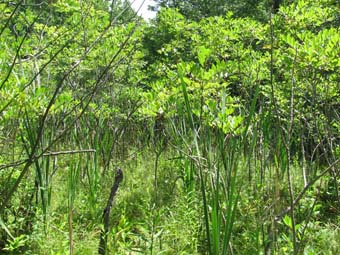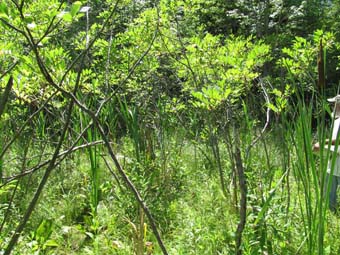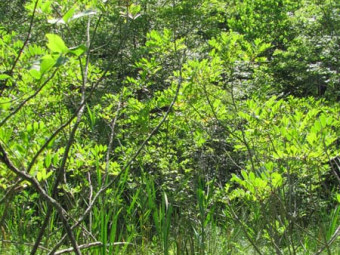Poison Sumac – Red-cedar – Bayberry Fen
System: Palustrine
Subsystem: Shrubland
PA Ecological Group(s): Peatland Wetland
Global Rank:GNR
![]() rank interpretation
rank interpretation
State Rank: S1
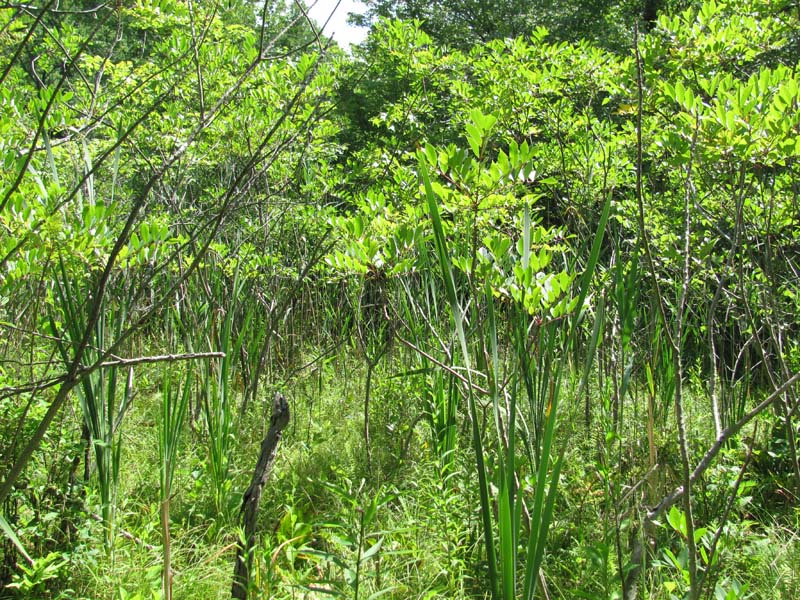
General Description
This community type is specific to northeastern Pennsylvania and western New Jersey. These are wetlands that have developed under the influence of base-rich water and usually have a substantial organic layer. The pH of surface water during the growing season ranges from 7.0 to 8.1. Structurally, they are dominated by a mixture of shrubs and herbaceous plants (predominantly sedges). Most sites have areas in the wettest portions that are without woody vegetation. Depth of organic matter ranges from zero in actively seeping areas to over a meter in basins. The dominant shrubs include eastern red-cedar (Juniperus virginiana), bayberry (Myrica pensylvanica), poison sumac (Toxicodendron vernix), willows (Salix spp.), shrubby cinquefoil (Potentilla fruticosa), gray dogwood (Cornus racemosa), alder-leaved buckthorn (Rhamnus alnifolia), and ninebark (Physocarpus opulifolius). Herbaceous species include Atlantic sedge (Carex sterilis), yellow sedge (Carex flava), sedge (Carex tetanica), sedge (Carex lurida), tussock sedge (Carex stricta), spike muhly (Muhlenbergia glomerata), capillary beak-rush (Rhynchospora capillacea), white beak-rush (Rhynchospora alba), brook lobelia (Lobelia kalmii), spotted Joe-Pye-weed (Eutrochium maculatum), swamp thistle (Cirsium muticum), marsh fern (Thelypteris palustris), mountain-mint (Pycnanthemum virginianum), meadow spikemoss (Selaginella apoda), bugleweed (Lycopus uniflorus), round-leaved sundew (Drosera rotundifolia), grass-of-Parnassus (Parnassia glauca), calico aster (Symphyotrichum lateriflorum), and New York ironweed (Vernonia noveboracensis). Characteristic bryophytes include Campylium stellatum, Aulacomnium palustre, Fissidens adiantoides, and Bryum pseudotriquetrum. Chara spp. (stoneworts) occur in seeps and in unvegetated flats.
Rank Justification
Critically imperiled in the jurisdiction because of extreme rarity or because of some factor(s) such as very steep declines making it especially vulnerable to extirpation.
Identification
- Dominated by eastern red-cedar (Juniperus virginiana), bayberry (Myrica pensylvanica), poison sumac (Toxicodendron vernix), and shrubby cinquefoil (Potentilla fruticosa)
- Occurs in eastern Pennsylvania
- Calcareous soils
Shrubs
Herbs
- Atlantic sedge (Carex sterilis)
- Yellow sedge (Carex flava)
- Wood's sedge (Carex tetanica)
- Sedge (Carex lurida)
- Tussock sedge (Carex stricta)
- Spike muhly (Muhlenbergia glomerata)
- Capillary beak-rush (Rhynchospora capillacea)
- White beak-rush (Rhynchospora alba)
- Brook lobelia (Lobelia kalmii)
- Spotted joe-pye-weed (Eutrochium maculatum)
- Swamp thistle (Cirsium muticum)
- Marsh fern (Thelypteris palustris)
- Mountain-mint (Pycnanthemum virginianum)
- Meadow spikemoss (Selaginella apoda)
- Bugleweed (Lycopus uniflorus)
- Round-leaved sundew (Drosera rotundifolia)
- Grass-of-parnassus (Parnassia glauca)
- Calico aster (Symphyotrichum lateriflorum)
- New York ironweed (Vernonia noveboracensis)
Exotic Species
* limited to sites with higher soil calcium
Vascular plant nomenclature follows Rhoads and Block (2007). Bryophyte nomenclature follows Crum and Anderson (1981).
International Vegetation Classification Associations:
USNVC Crosswalk:None
Representative Community Types:
Northern Piedmont Rich Fen (CEGL006103)
NatureServe Ecological Systems:
North-Central Appalachian Seepage Fen (CES202.607)
NatureServe Group Level:
None
Origin of Concept
Fike, J. 1999. Terrestrial and palustrine plant communities of Pennsylvania. Pennsylvania Natural Diversity Inventory. Pennsylvania Department of Conservation and Recreation, Bureau of Forestry, Harrisburg, PA. 86 pp.
Pennsylvania Community Code*
SP : Poison Sumac – Red-Cedar – Bayberry Fen
*(DCNR 1999, Stone 2006)
Similar Ecological Communities
This type is ecologically similar to and shares many species with the Alder-leaved Buckthorn – Inland Sedge – Golden Ragwort Shrub Fen type. The two differ in their distribution and species composition with the Posion Sumac – Red-cedar – Bayberry Fen occurring in the eastern portion of Pennsylvania and dominated by eastern red-cedar (Juniperus virginiana), bayberry (Myrica pensylvanica), poison sumac (Toxicodendron vernix), and shrubby cinquefoil (Potentilla fruticosa).
Fike Crosswalk
Poison Sumac – Red-cedar – Bayberry Fen
Conservation Value
Poison Sumac – Red-cedar – Bayberry Fen occurs in calcareous wetlands, which are especially unusual in Pennsylvania, where the predominant geology in most regions is acidic. There are a number of plants, aquatic invertebrates, and lepidopterans adapted specifically to this high-pH wetland habitat. Plants of special concern in Pennsylvania that are found in this habitat include Atlantic sedge (Carex sterilis), yellow sedge (Carex flava), sedge (Carex tetanica), capillary beak-rush (Rhynchospora capillacea), brook lobelia (Lobelia kalmii), and grass-of-Parnassus (Parnassia glauca).
Threats
The greatest threats to these communities are extraction of bedrock and glacial deposits or disruption to groundwater flow from activities such as drilling or mining in nearby areas and groundwater extraction, which can contaminate or alter the flow patterns of the groundwater that feeds the seepage. Groundwater pollution can also occur from improperly installed septic systems, from improperly lined underground waste disposal, and in agricultural areas, from infiltration of pesticides, fertilizer, and bacteria from animal wastes. Invasive plant species, such as common reed (Phragmites australis ssp. australis) and both native and invasive cat-tail species (Typha spp.) can threaten the biological integrity of the community. Wetland soils and vegetation are sensitive and will be damaged by foot traffic or recreational vehicles as they are easily compacted.
Management
Drilling, mining, or other disruptions to bedrock or glacial deposits should not be undertaken within a half mile of a seepage wetland without a thorough understanding of bedrock layers and groundwater flows. Groundwater flow patterns do not always mirror surface watersheds, and in some cases aquifers may be contiguous over large areas. Seepage wetlands are also sensitive to trampling and other physical disturbance from recreational activities; trails should be sited away from the wetland or elevated structures employed to prevent traffic in the wetland. A natural buffer around the wetland should be maintained in order to minimize nutrient runoff, pollution, and sedimentation. The potential for soil erosion based on soil texture, condition of the adjacent vegetation (mature forests vs. clearcuts), and the topography of the surrounding area (i.e., degree of slope) should be considered when establishing buffers. The buffer size should be increased if soils are erodible, adjacent vegetation has been logged, and the topography is steep as such factors could contribute to increased sedimentation and nutrient pollution. These wetlands may require periodic disturbance such as burning or grazing to maintain their open canopy which is indicative of this community and the rare species that occupy it.
Research Needs
More site inventory and classification work is needed to refine the definition of this community type and resolve its relationship to other types. It appears that some of these wetlands will succeed to shrubland if not maintained. Management of these wetlands would be informed by an understanding of natural successional pathways and of the historical frequency of disturbances such as fire and grazing in these wetlands.
Trends
Specific information on the loss and degradation of this community is not available. However, most calcareous soils in Pennsylvania occur in valleys or glaciated regions that are also favorable for agriculture and settlement, and have been extensively cleared of natural vegetation for these purposes. This community type is likely to have been lost or altered at a disproportionately high rate to other wetland types.
Range Map
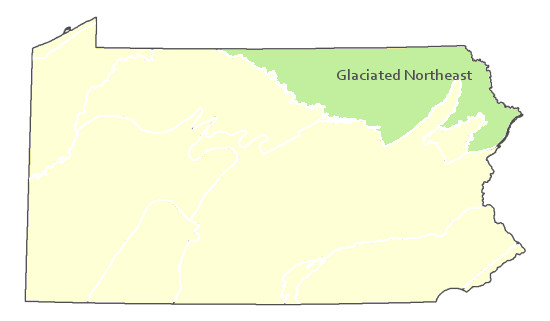
Pennsylvania Range
NE Pennsylvania
Global Distribution
New Jersey, New York, and Pennsylvania
Pennsylvania Department of Conservation and Natural Resources (DCNR). 1999. Inventory Manual of Procedure. For the Fourth State Forest Management Plan. Pennsylvania Bureau of Forestry, Division of Forest Advisory Service. Harrisburg, PA. 51 ppg.
Stone, B., D. Gustafson, and B. Jones. 2006 (revised). Manual of Procedure for State Game Land Cover Typing. Commonwealth of Pennsylvania Game Commission, Bureau of Wildlife Habitat Management, Forest Inventory and Analysis Section, Forestry Division. Harrisburg, PA. 79 ppg.
Cite as:
Podniesinski 2022. Pennsylvania Natural Heritage Program. Poison Sumac – Red-cedar – Bayberry Fen Factsheet. Available from: https://naturalheritage.state.pa.us/Community.aspx?=16045 Date Accessed: January 11, 2026

